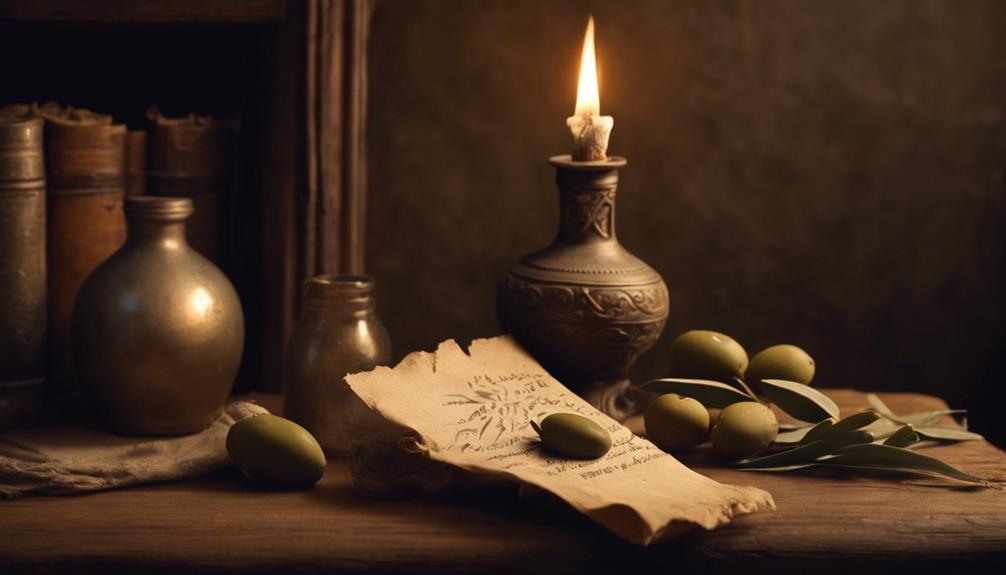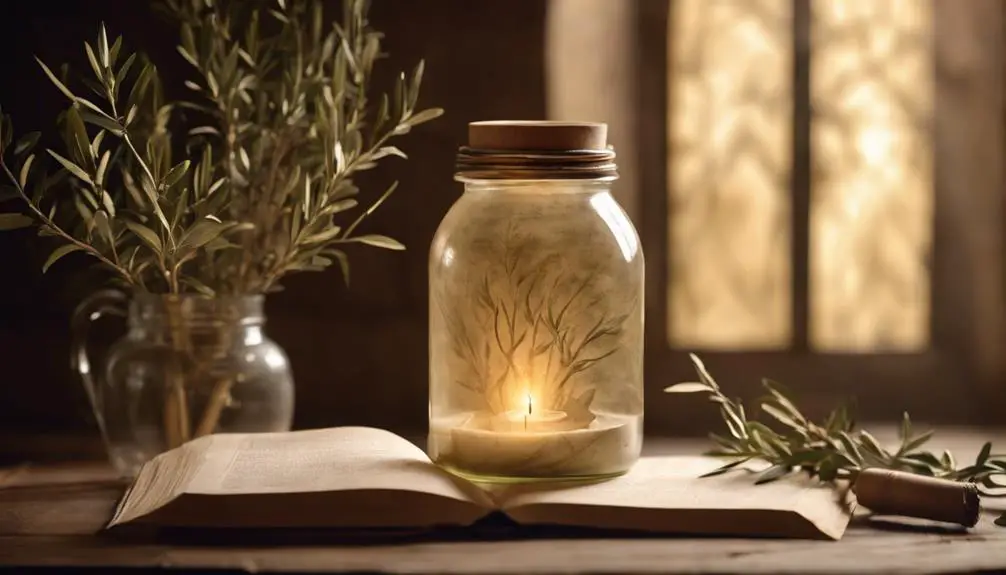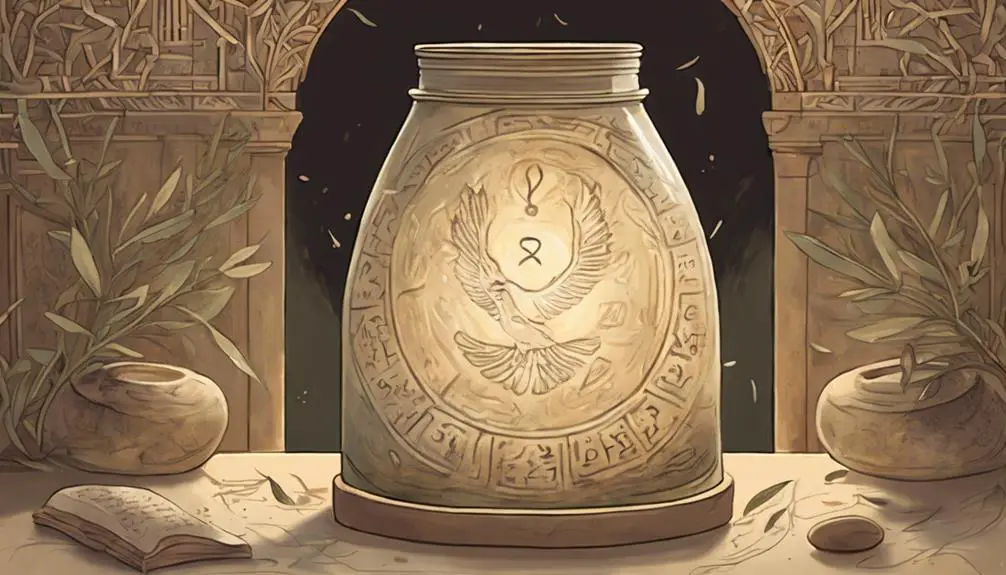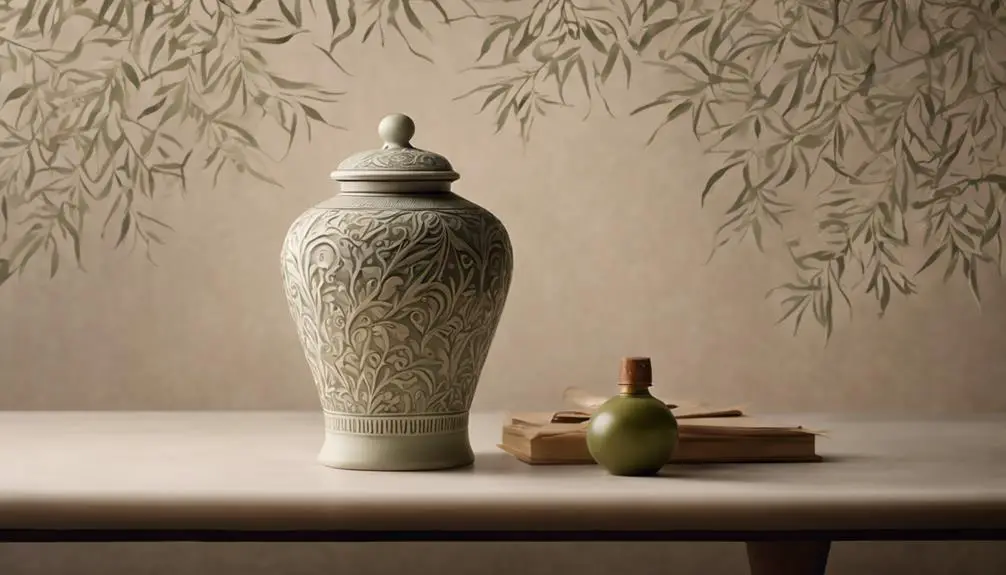Explore the poignant symbolism of tear jars in the Bible, revealing deep layers of grief, remembrance, and the human connection to the divine.

Tear Jar in the Bible
In the tapestry of biblical narratives, the tear jar holds a unique thread, symbolizing the depth of human sorrow and divine remembrance.
You'll find its historical origins deeply rooted in ancient practices, where emotions were not just felt but collected.
The biblical references to these vessels open a window into the lives of those who lived millennia ago, offering you a glimpse into their soulful expressions of grief and devotion.
As you explore the symbolic meanings and cultural practices surrounding tear jars, you'll uncover layers of significance that resonate even in today's digital age, inviting you to ponder on the timeless nature of human emotion and memory.
Key Takeaways
- Biblical texts, like Psalm 56:8 and Luke 7:38, mention tear jars, underscoring their emotional and religious importance.
- Tear jars in the Bible symbolize God's awareness and care for human suffering and grief.
- Instances in biblical narratives show tears as potent symbols of human emotion and divine connection.
- The tradition of tear jars reflects a profound interaction with the divine, validating and commemorating individuals' feelings of sorrow and loss.
Historical Origins

While the concept of a tear jar might seem novel, its historical origins are deeply rooted in ancient Near Eastern cultures, where it served as a tangible expression of grief and mourning. The artifact discovery of these tear jars offers profound insights into the socio-cultural practices of antiquity. Each jar, meticulously unearthed by archaeologists, provides a unique window into the past, revealing not just the prevalent customs but also the shared human experience of coping with loss.
Material analysis plays a crucial role in understanding these artifacts' significance. The composition of tear jars, often made from pottery or glass, indicates the technological capabilities and artistic sensibilities of the cultures that produced them. Furthermore, the analysis helps in dating these objects, thereby placing them accurately within the historical timeline. It's fascinating how these vessels, once holding the tears of mourners, now serve as a testament to the universality of emotional expression across civilizations.
Biblical References

Having explored the historical origins of tear jars, we now turn our attention to their mention and significance within biblical texts. The Bible, rich in metaphor and symbolism, also allows for literal interpretation, especially when artifacts like tear jars are mentioned. Understanding these references within their scriptural context offers deeper insights into the emotional and spiritual landscape of biblical times.
Reference |
Context |
Significance |
|---|---|---|
Psalm 56:8 |
David speaks of his tears being stored in God's bottle. |
Indicates God's attentiveness to human suffering. |
Luke 7:38 |
A woman washes Jesus' feet with her tears. |
Demonstrates a profound act of repentance and love. |
2 Kings 20:5 |
God responds to Hezekiah's tears with a promise of healing. |
Shows that tears can be a powerful prayer. |
Jeremiah 9:1 (Symbolic) |
Jeremiah wishes his head were a spring of tears. |
Expresses deep sorrow for his people's plight. |
These instances highlight the tear jar's role not just as a physical object but as a vessel for profound emotional expression and divine interaction. The literal interpretation of these passages within their scriptural context underscores the significance of tears and their acknowledgment by the divine.
Symbolic Meanings

Beyond their physical presence in biblical narratives, tear jars carry deep symbolic meanings, reflecting the complexity of human emotions and divine responses. These vessels, often overlooked, are potent symbols of emotional expression and mourning rituals within the biblical context. They encapsulate the sorrow, grief, and sometimes even repentance of individuals, offering a tangible representation of inner turmoil and suffering.
The act of collecting tears in jars signifies not only the personal acknowledgment of pain but also a societal recognition of the significance of mourning. This practice underscores the importance of expressing grief, validating the mourner's feelings, and providing a physical form to the often invisible process of healing. The tear jar, therefore, becomes a sacred container for personal anguish, a symbol that human suffering is seen, valued, and remembered.
Moreover, these jars highlight the empathetic nature of the divine, suggesting that every tear shed is noticed and cherished by a higher power. This notion offers comfort and reassurance to the faithful, emphasizing that their emotional expressions, encapsulated in the tear jars, have both a temporal and eternal significance.
Cultural Practices

Throughout various cultures, the practice of collecting tears in jars has been a poignant ritual, embodying diverse traditions and beliefs associated with mourning and remembrance. This custom, deeply intertwined with funeral rites, serves not only as a tangible expression of grief but also as a medium for honoring and connecting with the departed. In many societies, these tear jars hold a sacred place in the ceremonies that surround death, symbolizing both a release of sorrow and a tribute to those who've passed.
Ancestral worship, a practice rooted in the belief of honoring and remembering the dead, often incorporates the use of tear jars. These containers, filled with the tears of the bereaved, are sometimes placed in burial sites or kept within homes as a symbol of respect and remembrance. By preserving these tears, families believe they maintain a connection with their ancestors, bridging the gap between the living and the dead. This ritual underscores the importance of memory and the enduring bonds of family and community in the face of loss.
Analyzing these practices reveals a universal theme: the human need to commemorate and make sense of death. Through the act of collecting tears, people across cultures find a means to externalize their grief, encapsulate their love, and perpetuate the legacy of those they mourn.
Modern Resonance

In today's society, the tradition of collecting tears in jars resonates deeply, reflecting enduring human efforts to navigate and articulate the complexities of grief. This practice, rooted in ancient customs, has found modern significance, offering a tangible means to process and memorialize personal loss. It embodies a physical manifestation of sorrow, serving as a tool for personal healing and emotional validation.
The act of collecting tears, once a symbolic gesture of mourning and remembrance in biblical times, now underscores the universal need for acknowledgment and expression of pain. It transcends cultural and temporal boundaries, encapsulating the timeless and shared experience of grief. In this context, tear jars become more than mere receptacles; they're vessels of healing, facilitating a journey through mourning toward recovery.
Moreover, the modern adaptation of this practice emphasizes the importance of validating one's emotions in the pursuit of mental health. By acknowledging grief's validity and complexity, individuals find solace and understanding. This process of emotional validation is crucial, as it encourages openness and supports the natural course of healing, underscoring the profound resonance of tear jars in contemporary society.
Frequently Asked Questions
How Does One Go About Creating a Replica of a Biblical Tear Jar With Historically Accurate Materials and Techniques?
To create a replica of a historical tear jar, you'll need to focus on material sourcing and the crafting process.
First, research the materials used historically, likely clay or glass. Then, learn ancient pottery or glassblowing techniques to mimic those used in the past.
It's crucial to study artifacts and scholarly works to understand the design and function of these jars, ensuring your replica is as historically accurate as possible.
Are There Any Recorded Instances of Prominent Historical Figures Outside the Biblical Context Using Tear Jars?
Yes, there are recorded instances of prominent historical figures outside the biblical context using tear jars. These artifacts weren't limited to biblical traditions but were part of broader ancient customs, often associated with mourning rituals.
Interestingly, you'll find that they also held roles in ancient cosmetics and maritime practices, storing precious oils or serving as symbolic offerings to the sea. Their usage reflects a fascinating intersection of personal, cultural, and practical significance.
How Have Tear Jars Been Interpreted or Reimagined in Contemporary Art, Literature, or Film Outside of Religious Contexts?
In contemporary realms, tear jars have inspired a myriad of creative expressions. You'll find tear-inspired art and emotional sculptures that delve deep into the human psyche, exploring themes of grief, love, and memory.
Artists and filmmakers reimagine these ancient vessels, often stripping them of their religious connotations to highlight universal experiences of sorrow and healing. This reimagining invites viewers to reflect on the cathartic power of tears, transforming personal grief into collective empathy.
Can the Concept of a Tear Jar Be Found in Religious or Cultural Traditions Outside of the Judeo-Christian Heritage?
Yes, you'll find the concept of a tear jar in traditions beyond Judeo-Christian heritage.
For instance, in Ancient Egyptian customs, containers were used to collect tears as part of funeral rituals, symbolizing mourning and respect for the deceased.
Similarly, during the Victorian era, mourning practices included the use of tear bottles to capture grief, reflecting a tangible connection to the departed.
These examples illustrate the universal expression of sorrow and remembrance across cultures.
What Psychological Implications Might the Practice of Collecting Tears in Jars Have on Individuals Grieving or Experiencing Sorrow, According to Modern Psychology?
Collecting tears in jars as a coping mechanism might significantly influence your emotional resilience during grief or sorrow. According to modern psychology, this practice can provide a tangible way to process and acknowledge your emotions, potentially leading to a healthier emotional state.
Engaging in such rituals allows you to externalize your grief, offering a physical form to your emotional pain, which can be crucial for healing and moving forward.
Conclusion
In conclusion, the concept of a tear jar, deeply rooted in historical origins and vividly referenced in the Bible, carries profound symbolic meanings. It bridges human emotions with divine acknowledgment, illustrating a tangible manifestation of grief and remembrance.
Cultural practices around tear jars further underscore their significance across civilizations, resonating into modern times. This enduring symbol highlights the timeless nature of human sorrow and the universal quest for comfort and connection, both earthly and divine.



Sign up